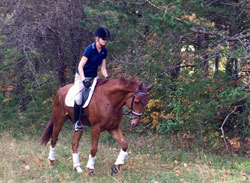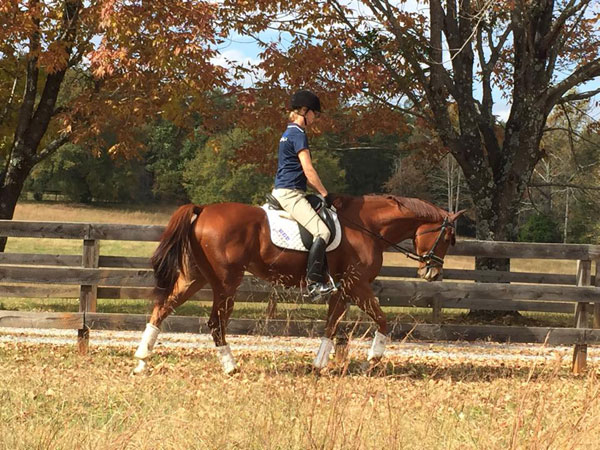Now this is what I’m talkin’ about!
Getting the young horse, or more specifically, my young horse, out of the arena and riding into the open. And this is the time of year, with the splendor of autumnal colors mellowing around us and crunching through leaves already fallen, that we dressage enthusiasts remember why we love riding in the first place: being on horseback and in the elements. Does it get any better? Each day I count my blessings that there are long, gradual inclines on the farm. Hill walking is a lovely, relaxed way to build muscle and overall fitness in a pleasant environment.
-forrest1.jpg)
I’m all about being in the elements on a 4 year old as long as I avoid being thrown into the element of dirt sometime during the ride. So in order to stay safe (as I generally ride on my own), I do my best to eliminate any factors that might result in a bucking spree during crisp November days: I longe Forrest first, lightly, in the arena, and then after mounting up, ride a few minutes on the flat making sure I have him on the aids before venturing out.
This is important not only for my own safety, but for the comfort and well being of Forrest’s back. The last thing I want to do on any horse is to climb aboard and head straight out to do hill work—that’s asking for pulled muscles and ligaments. Give them a chance to properly warm up so that they’re physically capable of working over their back as they walk both up and down hills, making the whole exercise as beneficial as possible.
When I rode with Jan Ebeling in California, it was always an enjoyable day when we students would follow him, single file, out the driveway, to hack the short distance to 8,000 acres of National Forest. It was marvelous! Instructed to trot along the wide, sandy paths, we would approach a long, dirt road that wound around quite an impressive hill. “Ride your horses a little deeper!” he would call out and so we did. Don’t mistake this for any sort of cranking nonsense with a backward hand. This was simply riding the horse’s neck a little lower from the withers so as to really help them stretch their topline and remain balanced as we ascended the hill, instead of inverting and pulling themselves along on the forehand. Those are wonderful memories, riding past the lemon groves to get to the park, with everyone, especially the horses, enjoying a break from 20 meter circles and renvers.
Now, on my own farm on the other side of the country, Forrest walked, sedately, along the entire perimeter of the small 5 acre field in both directions, three times, both going up.
And down, reaching and stretching.
I couldn’t have been prouder of him. He ignored the horses grazing in the adjoining field, and I felt so comfortable that when we were finished, we walked up the driveway into our quiet lane, turned around, and walked back down. For some reason, more than one horse has found the top of the driveway exposed and unsettling, so I always consider it a bit of a triumph when a youngster doesn’t make a big deal of it.



So don’t let this wonderful autumn go by without riding smack dab in the middle of it. And remember: Olympian Carl Hester says he never works his horses, especially Valegro, more than three or four days a week in the arena. They all hack out! So, while we might not all be able to ride a Grand Prix for 80 percent, we can at least all exit at A and keep going for miles!











